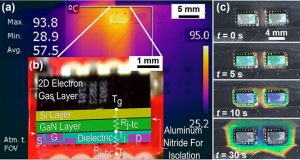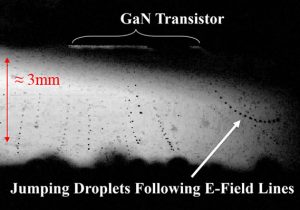Electric Field Jumping Droplet Condensation for Active Hot-Spot Cooling of High-Power-Density Electronics
PhD Thomas Foulkes with advisor R. Pilawa-Podgurski

Figure 12: (a) Thermal infrared image of GaN FET with (b) detailed device structure. (c) Top view time-lapse liquid crystal thermographic images of the two GaN device during startup. Thermal steady-state was reached at 30 s. Red corresponds to 70 °C and violet corresponds to 90 °C.
Enhanced cooling methods to remove heat generated by hot spots inside of power electronic devices, while not sacrificing weight and volume, are required to decrease overall size and weight of power electronic converters as shown in Figure 12. Leveraging recent advances in both wide-bandgap power transistors as well as single-and two-phase cooling, this work provides experimental results from an active phase-change cooling scheme that enables enhanced heat transfer without dramatically increasing the weight and volume of the complete converter system. Specifically, this study the first successful example of active steerable phase-change cooling of power electronics devices using electric-field-enhanced (EFE) jumping-droplet condensation as shown in Figure 13. In an ambient environment,

Figure 13: Composite image of several successive frames from a high speed video of electric-field-enhanced jumping-droplet condensation toward a GaN transistor
EFE condensation was shown to enhance the heat transfer from the local hot spot by approximately 200% compared to cooling without jumping and by 20% compared to non-EFE jumping. Dynamic switching of the electric field for a two-GaN system revealed the potential for active cooling of mobile hot spots. This work demonstrates both EFE condensation-based electronics cooling and provides a framework for the development of active jumping-droplet based vapor chambers and heat pipes capable of spatial and temporal thermal dissipation control. This research is supported by NASA and POETS ERC.